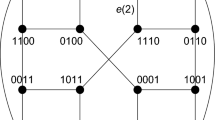Abstract
Network cost is equal to degree × diameter and is one of the important measurements when evaluating graphs. Torus and hypercube are very well-known graphs. When these graphs expand, a Torus has an advantage in that its degree does not increase. A hypercube has a shorter diameter than that of other graphs, because when the graph expands, the diameter increases by 1. Hypercube Qn has 2n nodes, and its diameter is n. We propose the rotational binary graph (RBG), which has the advantages of both hypercube and Torus. RBGn has 2n nodes and a degree of 4. The diameter of RBGn would be 1.5n + 1. In this paper, we first examine the topology properties of RBG. Second, we construct a binary spanning tree in RBG. Third, we compare other graphs to RBG considering network cost specifically. Fourth, we suggest a broadcast algorithm with a time complexity of 2n − 2. Finally, we prove that RBGn embedded into hypercube Qn results in dilation n, and expansion 1, and congestion 7.





Similar content being viewed by others
References
Mokhtar H, Zhou S (2017) Recursive cubes of rings as models for interconnection networks. Discrete Appl Math 217:639–662
Jahanshahi M, Bistouni F (2018) Interconnection networks. Crossbar-based interconnection networks. Springer, Cham, pp 9–39
McDonald N, Adriana F, Davis A, Isaev M, Kim J, Gibson D (2018) SuperSim: extensible flit-level simulation of large-scale interconnection networks. In: 2018 IEEE International Symposium on Performance Analysis of Systems and Software (ISPASS). IEEE, pp 87–98
Mokhtar H (2017) Cube-connected circulants as efficient models for interconnection networks. J Interconnect Netw 17.03n04:1741007
Rahman MMH, Mohammed NMA, Adamu AI, Dhiren KB, Yasuyuki M, Yasushi I (2019) A New static cost-effective parameter for interconnection networks of massively parallel computer systems. In: Soft computing data analytics. Springer, Singapore, pp 147–155
Habibian H, Patooghy A (2017) Fault-tolerant routing methodology for hypercube and cube-connected cycles interconnection networks. J Supercomput 73(10):4560–4579
Nai-Wen C, Sun-Yuan H (2018) Conditional diagnosability of (n, k)-star graphs under the PMC model. IEEE Trans Dependable Secure Comput 15(2):207–216
Decayeux C, Seme D (2005) 3D hexagonal network: modeling, topological properties, addressing scheme, and optimal routing algorithm. IEEE Trans Parallel Distrib Syst 16(9):875–884
EI-Amawy A, Latifi S (1991) Properties and performances of folded hypercubes. IEEE Trans Parallel Distrib Syst 2(1):31–42
Efe K (1991) A variation on the hypercube with lower diameter. IEEE Trans Comput 40(11):1312–1316
Mohan KJ, Pataik LM (1992) Extended hypercube: a hierarchical interconnection network of hypercubes. IEEE Trans Parallel Distrib Syst 3(1):45–57
Ghose K, Desai KR (1995) Hierarchical cubic network. IEEE Trans Parallel Distrib Syst 6(4):427–435
Shi W, Srimani PK (2005) Hierarchical star: a new two level interconnection network. J Syst Archit 51:1–14
Yun SK, Park KH (1996) Hierarchical hypercube networks (HHN) for massively parallel computers. J Parallel Distrib Comput 37:194–199
Duh D, Chen G, Fang J (1995) Algorithms and properties of a new two-level network with folded hypercubes as basic modules. IEEE Trans Parallel Distrib Syst 6(7):714–723
Malluhi QM, Bayoumi MA (1994) The hierarchical hypercube: a new interconnection topology for massively parallel system. IEEE Trans Parallel Distrib Syst 5(1):17–30
Seo JH (2013) Three-dimensional Petersen-torus network: a fixed-degree network for massively parallel computers. J Supercomput 64(3):987–1007
Parhami B, Yeh CH (2000) Why network diameter is still important. In: Proceedings of International Conference on Communications in Computing, pp 271–274
Saad Y, Schultz MH (1988) Topological properties of hypercubes. IEEE Trans Comput 37(7):867–872
Seo Jung-Hyun et al (2018) The hierarchical Petersen network: a new interconnection network with fixed degree. J Supercomput 74(4):1636–1654
Seo JH, Lee H (2013) Link-disjoint broadcasting algorithm in wormhole-routed 3D Petersen–Torus networks. Int J Distrib Sens Netw 9(12):501974
Seo JH, Lee H (2016) Embedding algorithm among half pancake, pancake, and star graphs. Int J Softw Eng Appl 10(3):191–204
Acknowledgements
This research was supported by Basic Science Research Program through the National Research Foundation of Korea (NRF) funded by the Ministry of Education (2017R1D1A3B03032173).
Author information
Authors and Affiliations
Corresponding author
Additional information
Publisher's Note
Springer Nature remains neutral with regard to jurisdictional claims in published maps and institutional affiliations.
Rights and permissions
About this article
Cite this article
Seo, Jh., Lee, H. Design and analysis of the rotational binary graph as an alternative to hypercube and Torus. J Supercomput 76, 7161–7176 (2020). https://doi.org/10.1007/s11227-019-03115-x
Published:
Issue Date:
DOI: https://doi.org/10.1007/s11227-019-03115-x




